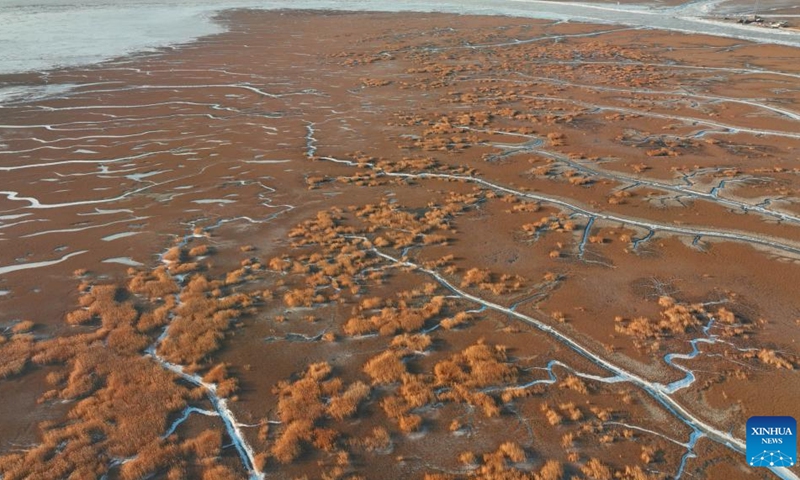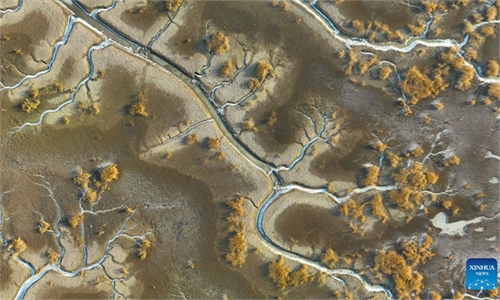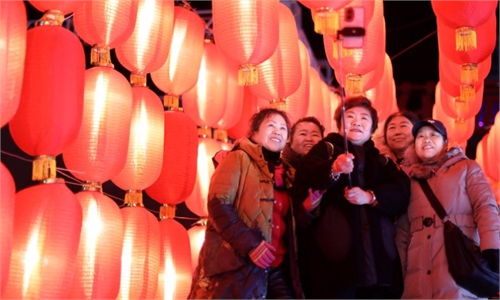ARTS / CULTURE & LEISURE
Symposium focuses on West Liaohe River, one of Chinese civilization’s major birthplaces

This aerial photo taken on Feb. 1, 2023 shows a view of frozen tidal creeks in the wetland of Liaohe River estuary in Panjin, northeast China's Liaoning Province.(Photo: Xinhua)
Dedicated to the historical development of the West Liaohe River, one of the three origins of China's 5,000 years of civilization, an academic symposium was recently held in Tongliao, North China's Inner Mongolia Autonomous Region.
The academic gathering has a special take that it compares the West Liaohe River civilization in what is today Inner Mongolia to the Yellow River and Yangtze River cultures. The three are described by China's national research project on tracing the origins of Chinese civilization as the three major sources of the country's "diverse yet unified" culture.
The West Liaohe River is a representative of China's cultural diversity. Xue Ruiming, an archaeologist, told the Global Times that due to its geographical nature, the river area has "incubated quite a few ancient ethnic minority cultures, majorly nomadic" such as the ancient Xiongnu tribe, Mongolian culture, Xianbei - another powerful nomadic force that came after the Xiongnu - and also the Khitan or Qidan people.
"The West Liaohe River civilization can be seen as a totality of different tribe cultures with unique ethnic minority characteristics," Xu noted, adding that the aim of viewing it with such a "comparative approach" was to find how it converged with the ancient Central Plains' cultures.
The river area possesses around 400 cultural heritage sites that "document ancient human history from 10,000 years ago," archaeologist Wang Meng, told the Global Times.
At the symposium, 10 academic reports were given by national-wide experts to discuss topics such as the "Hongshan Culture and jade tradition," "The development and integration of ancient people of the West Liaohe River" and "Hongshan Culture and the origin of Chinese civilization."
The West Liaohe River Culture is now identified with some notable cultural phases like the middle Neolithic Xinglongwa culture and also the late Hongshan Culture.
Wang told the Global Times that the Hongshan Culture, located at Chifeng, Inner Mongolia, and known for its prolific ritual jade and pottery artifacts, was inspired by the Central Plain's Yangshao Culture, revealing the integration of geographically different ancient Chinese civilizations.
"The diverse yet integrated Chinese civilization was formed on the basis of mutual exchange and interaction of various prehistoric regional cultures," Sun Yonggang, the head of the history and culture department at Chifeng University, said.
The West Xiliao River basin covers around 138,000 square kilometers. The symposium also discussed the cultural management of such a vast area.
In recent years, local archaeologists have been stepping up investigations and excavations around the river area. Taking the city of Tongliao as an example, more than 2,400 immovable cultural relics and 78,000 movable cultural relics have been discovered in recent years.
Subjects such as how to conserve cultural heritage during urban construction and how to better represent the river area's civilization on the international stage were also discussed at the academic meeting.
A similar symposium addressing the West Liaohe River's cultural value was held in 2022. The theme was focused on turning ancient culture into modern city landmarks and a cultural symbol of Tongliao.
Several cultural projects, such as a documentary film called The Flowing Civilization - the West Liaohe River and a book series dedicates to the culture are underway.
Global Times


